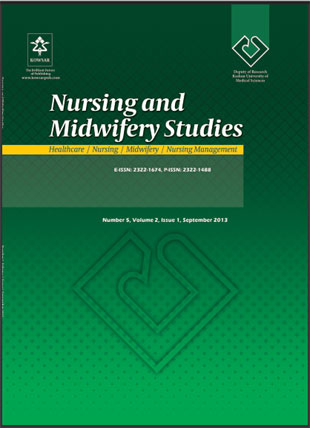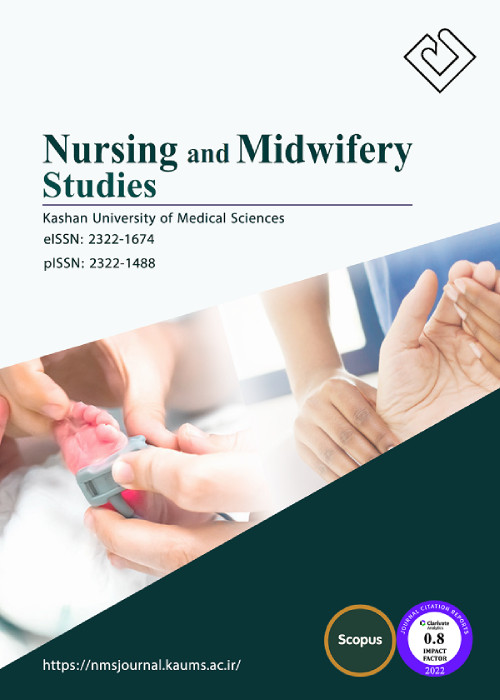فهرست مطالب

Nursing and Midwifery Studies
Volume:2 Issue: 1, Jan-Mar 2013
- تاریخ انتشار: 1392/07/07
- تعداد عناوین: 10
-
-
Pages 3-9BackgroundThe anxiety reduction before coronary angiography has clinical advantages and is one of the objectives of nursing. Reflexology is a non-invasive method that has been used in several clinical situations. Applying reflexology might have effect on the reduction of anxiety before coronary angiography..ObjectivesThe aim of this randomized clinical trial was to investigate the effect of reflexology on anxiety among patients undergoing coronary angiography..Patients andMethodsThis trial was conducted in Shahid Beheshti Hospital, in Kashan, Iran. One hundred male patients who were undergoing coronary angiography were randomly enrolled into intervention and placebo groups. The intervention protocol was included 30 minutes of general foot massage and the stimulation of three reflex points including solar plexus, pituitary gland, and heart. The placebo group only received the general foot massage. Spielbergers state trait anxiety inventory was used to assess the anxiety experienced by patients. Data was analyzed using Man-Witney, Wilcoxon and Chi-square tests. The stepwise multiple regressions used to analyze the variables that are involved in anxiety reduction..ResultsThe mean range of anxiety decreased from 53.24 to 45.24 in reflexology group which represented 8 score reduction (P = 0.0001). The reduction in anxiety was 5.9 score in placebo group which was also significant (P = 0.0001). The anxiety reduction was significantly higher in reflexology group (P = 0.014). The stepwise multiple regression analysis showed that doing reflexology can explain the 7.5% of anxiety reduction which made a significant model..ConclusionsReflexology can decrease the anxiety level before coronary angiography. Therefore, reflexology before coronary angiography is recommended..Keywords: Foot massage, Anxiety, Coronary angiography
-
Pages 10-15BackgroundInconsistent results have been reported on the effect of massage therapy on the blood cortisol levels. Also, no study is available about the effect of massage done by patient''s companions on the level of blood cortisol in patients hospitalized at CCU..ObjectiveThe present study aimed to evaluate the effect of whole body massage performed by patient''s companion on the level of blood cortisol among the patients admitted in CCU..Patients andMethodsA randomized controlled trial was conducted on 60 patients admitted to a CCU ward. Patients were randomly placed into two groups of massage performed by patient''s companion and the control group. In the intervention group, whole body massage was administered. The control group did not receive massage. Data analysis was performed using the SPSS 11.5 software. Independent sample and Paired samples t-test, Chi Square and Fisher''s Exact tests were used to analyze the data..ResultsThe mean age for the patients was 58.90 ± 15.63 years. None of them had the history of massage therapy. In the group massaged by the patients'' companions, the mean of blood cortisol was 323.6 ± 162.6 nanomoles which decreased to 268.4 ± 141.1 after the intervention (P < 0.102). The mean of blood cortisol in the control group did not change significantly..ConclusionsMassage therapy lowered the level of cortisol in the group massaged by the patients'' companions. It can be recommended that massage therapy be used in patients admitted in CCU..Keywords: Massage therapy, Relatives, Coronary patients, Cortisol
-
Pages 16-20BackgroundAnxiety disorders are common and test stress affects many students. Guided reflection is a new and effective method for reducing stress..ObjectivesTo assess the effect of guided reflection on test anxiety in second and third-year nursing students of Fatima Nursing and Midwifery College, Shiraz University of Medical Sciences, Shiraz, Iran..Materials And MethodThis study was designed to assess the effect of guided reflection on test anxiety among nursing students of second and third year of education in Faculty of Nursing and Midwifery, Shiraz University of Medical Sciences, Shiraz, Iran. Data was collected using demographic data questionnaires and the Sarason and Abolghasemi test anxiety scale. Based on the latter questionnaire, of the 147 participants, 100 had test anxiety with scores ranging from 13-63 (mild-severe anxiety), of which 80 students were randomly selected and divided into case and control groups. We used Johns’s 9-stage guided reflection model through Q and A, lecture, and discussion. The case group participated in a 2-day guided reflection workshop for six hours each day. The control group received no intervention. Sarason and Abolghasemi’s test anxiety questionnaire was completed by the students at the beginning of the first session, immediately after and three months after intervention..ResultsThe test anxiety mean scores were 35.34 ± 9.50 and 35.47 ± 10.66 before the intervention in the control and intervention groups respectively. No significant difference was found between the two groups with respect to socio-demographic characteristics. The Mean ± SD of test anxiety scores increased to 36.48 ± 9.34 three months after the intervention in the control group (P = 0.1). However, in the intervention group, the Mean ± SD test anxiety scores reduced immediately after (16.31 ± 8.61) and three months after (27.72 ± 10.09) the intervention, compared to before the intervention (35.47 ± 10.66) (P < 0.001, paired T-test)..ConclusionsGuided reflection is effective in reducing test anxiety in nursing students. This method can be used for reducing test anxiety and increasing learning and academic progress among students..Keywords: Anxiety, Guided reflection, Nursing students, Test
-
Pages 21-27BackgroundThe independent roles of midwives have not been properly defined, and midwifery ethical values and moral codes proper to Turkish culture have not been developed. The absence of legal regulations concerning midwifery has negatively affected midwifery in the process of professionalization..ObjectivesThe purpose of this study was to identify the professional values of midwifery in Turkey..Materials And MethodsA focus group was created with the participation of nine midwives working at two state hospitals and a university hospital that provide birth service for women in Kocaeli, which is the most important industrial city in Turkey. The opinions of the midwives on the characteristics that a good midwife should possess and the professional values that a good midwife should observe were collected via in-depth interviews. The interviews were recorded. A total of three meetings were held with the participants. Finally, the notes taken by the reporter during these interviews were rearranged, and the recordings were transcribed by the researchers..ResultsThe characteristics suggested by the participants were classified into three categories: professional, personal, and interpersonal. Professional competence, capacity to properly inform interested parties, trustworthiness, respect for individuals and human dignity, and empathy were the most commonly named characteristics. As for the professional values of midwifery, professional competence, trustworthiness, responsibility, maximum benefit, and protection of privacy were the most often identified. Midwives also reported that most of the difficulties they faced in the exercise of daily tasks concerned protecting the privacy of their patients as well as the integrity and prestige of the profession, achieving the maximum benefit and least harm for patients, and providing a just and equal service..ConclusionsThe professional values were mentioned by participant midwives were similar to the values proposed by international professional organizations. But there were some differences perhaps due to cultural differences..Keywords: Midwifery, Codes of ethics, Social values, Social characteristics
-
Pages 28-33BackgroundBehaviour Change Communication (BCC) is a key component of the roadmap adopted by the Nigerian government to address the high maternal and child mortality in the country..ObjectivesThe purpose of the study was to appraise the participation of midwives in BCC at the first level of health care in Kaduna State, Nigeria before planning a context specific and sustainable BCC capacity building programme..Materials And MethodsIn-depth interviews were conducted with nine midwives selected by maximum variation technique across Kaduna State. Content analysis of the interviews was performed using a priory codes derived from the integrative framework..ResultsThe integrative framework provided a comprehensive appraisal of BCC in the facilities. Health talks were unplanned, difficult and more task-oriented than being behaviour change focused. The required skills, integrated services to enhance behaviour change by clients, and enabling environment, were missing. The findings were used, in collaboration with the midwives to develop and implement a context specific and efficient capacity building programme..ConclusionsThe framework was adequate in identifying the gaps in the BCC activities of midwives at the facilities. There is a need to understand and support midwives with their BCC activities. Government policies should be brought closer to frontline staff who would implement them, by engaging such staff all through the process of developing the policies..Keywords: Behaviour change communication, Integrative framework, Midwife, Appraisal
-
Pages 34-38BackgroundCognitive impairment is increasingly recognized as a common adverse consequence of heart failure. Both Heart failure and cognitive impairment are associated with frequent hospitalization and increased mortality, particularly when they occur simultaneously..ObjectivesTo determine cognitive function and related factors in patients with heart failure..Materials And MethodsIn this descriptive cross-sectional study, we assessed 239 patients with heart failure. Data were collected by Mini Mental status Examination, Charlson comorbidity index and NYHA classification system. Data were analyzed using descriptive statistics, Kolmogorov-Smirnov test, chi-square test, t-test and logistic regression analysis..ResultsThe mean score of cognitive function was 21.68 ± 4.51. In total, 155 patients (64.9%) had cognitive impairment. Significant associations were found between the status of cognitive impairment and gender (P < 0.002), education level (P < 0.000), living location (P < 0.000), marital status (P < 0.03), living arrangement (P < 0.001), employment status (P < 0.000), income (P < 0.02), being the head of family (P < 0.03), the family size (P < 0.02), having a supplemental insurance (P < 0.003) and the patient’s comorbidities (P < 0.02). However, in logistic regression analysis, only education and supplementary insurance could predict cognitive status which indicates that patients with supplementary insurance and higher education levels were more likely to maintain optimal cognitive function..ConclusionsMore than a half of the subjects had cognitive impairment. As the level of patients cognitive functioning affects their behaviors and daily living activities, it is recommended that patients with heart failure should be assessed for their cognitive functioning..Keywords: Executive function, Cognitive disorders, Heart failure
-
Pages 39-43BackgroundHealth assessment skills are of the most important skills which nurses require. The more precise assessment, the better results would be obtained and the quality of patient care would be improved. However, in Iran, few studies have investigated nurses’ assessment skills..ObjectivesThis study was aimed to assess nurses'' evaluation of the learned skills of health assessment and their use..Materials And MethodsThis cross-sectional study was conducted on 200 nurses in Isfahan province hospitals. Data was collected by a questionnaire including demographic data and 120 health assessment skills. Nurses scored their frequency of using and proficiency in skills. Statistical analysis was conducted by ANOVA, Tukey test and independent sample T-tests..ResultsThe highest level of using and proficiency in skills was related to taking history. Nurses received 87.25% of score in this field. The lowest level of application was in assessment of the urogenital system so that nurses received 16.37% of score in this area. Also the lowest proficiency was in assessment of the nervous system and nurses received 34.58% of score in this area..ConclusionsThe level of nurses'' proficiency in the health assessment skills was not satisfactory. Modifying the curriculum and cooperating of nurse managers and nursing schools can help to improve the situation..Keywords: Health assessment, Clinical education, Nursing, Clinical skills


